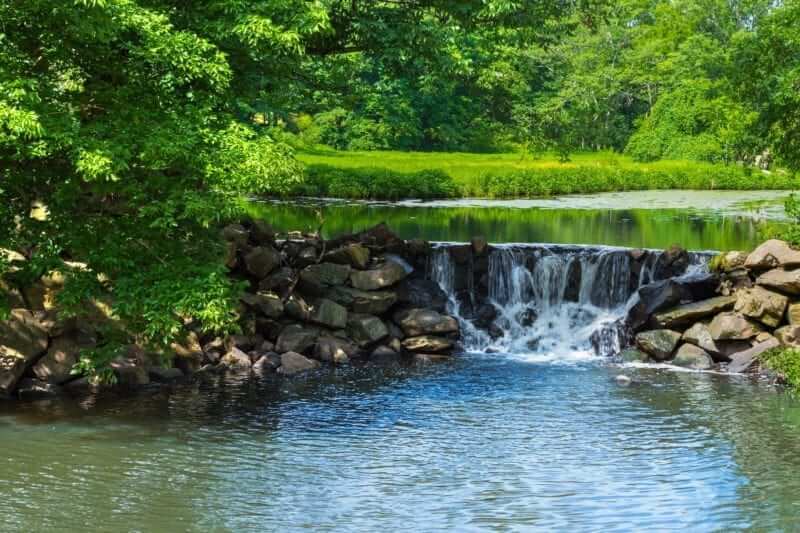A New Jersey teacher takes us on a tour of an educational destination that is sure to inspire students and teachers alike — to Duke Farms in Hillsborough, NJ.
I have stumbled on a hidden gem, and I would like to share this amazing resource with all my teacher and parent friends.
Have you heard of Duke Farms? It is located in Hillsborough, N.J., right along the Raritan River and not too far from Rutgers (1112 Dukes Parkway West). It is open every day but Wednesday from 8:30 a.m. – 6:00 p.m. Duke Farms offers hiking trails, bikes to rent, an orientation building, a community garden, a permaculture garden, festivals, PD opportunities and workshops, community and family classes, an orchid greenhouse, a cafe, a weekly farmers market, a tram and paved paths (wheelchair/stroller accessible paths, tram for disabled), and…comes with an interesting past.
I just attended a workshop there and I was blown away by the facilities and what they can offer me as a teacher, and as a mom. (I’ll share what they did for offer me…but you’ll have to wait for part 2, or check it out for yourself at http://dukefarms.org/) Did I mention there is no cost to get in?
Duke Farms has a fascinating history. It was previously owned by Doris Duke, the wealthy heiress of James Buchanan and Nanaline Duke who made their fortune in tobacco, textiles, and hydropower supply. Beginning in 1893, he pieced together small farms into the 2,700 acre estate present today which is three times the size of Central Park. He reshaped the land to look more like the North Carolina home that he grew up in. Buchanan diverted the Raritan River to fill the nine lakes that he dug, and using the fill to create the rolling hills that felt more like home to him. Their only daughter, Doris, was raised at the farm. She inherited the family fortune at the young age of 12, when her father died in 1925, turning her into “the richest little girl in the world.”
Doris loved Duke Farms, and it was her residence of choice by the age of 15. As she grew, she realized the importance of conservation, making her an environmentalist before her time. She loved animals, especially her dogs and pet camels (one is buried on site at the family pet cemetery), and later in life became an avid supporter of wild life animal refuges.
She had a passion for ecology, using new, innovative, and environmentally friendly farming techniques on her estate and growing her cherished orchids in the glass conservatory (still there today). She collected plants from around the world in order to create Duke Gardens — her international botanical collections that she opened to the public. Here our stories cross as my own beloved grandmother, a lover of nature, wildlife, and gardening- traveled to see this phenomenal collection.
Doris was also an extensive world traveler, collecting art as she worked and played: perhaps when working in Egypt at a canteen for sailors during World War II, or when reporting from various war torn locations in Europe as a foreign correspondent for the International News Service, maybe in Paris while writing for the magazine, Harper’s Bazaar, or maybe while winning a surfing championship in Hawaii! These pieces and sculptures were carefully placed into her homes and gardens- and some are still on site today, some exactly where she placed them.
When Doris died, her will left strict preservation methods for her pristine and historical homes in Newport and Hawaii. But no such plans were left for Duke Farms (which housed an ill-kept 67,000 square foot country manor that was demolished in 2016). While her parents had intended on building a grand mansion, the project was abandoned during World War I. Her father had dug and built the foundation, a grand fountain, vast stone fencing, a terrace and balcony and great staircases to lead up to the home. But the intended mansion was never actually built- and the manor, that started as a 50 room residence grew to an immense 67,000 square feet by the time of her death.
For her beloved Duke Farms, Doris wanted a place to promote conservation, to protect wildlife and the environment, to create a haven for New Jersey flora and fauna and provide a place to be used for agriculture, horticulture, and research. Ultimately, she wanted it to be enjoyed by the public- a dream that started in her father, but was passed to her, and carried out through her will. In 1998 The Duke Farms Foundation was established to manage the estate.
With the legacy of Doris at the forefront of their plans, the Duke Farms Foundation set their mission, “to be a leader in environmental stewardship and to inspire visitors to become informed stewards of the land.” They made plans to restore and repair the land and set about a $45 million dollar remodel. Duke Farms opened to the public on May 19, 2012 for the first time in more than 100 years. The once private estate was now transformed into more than 1,000 acres of New Jersey native plants and wildlife, focussed on sustainability and environmental protection.
Aspiring not to leave a carbon footprint, they have a no car (they stay at the entrance), no dogs and no garbage (what you bring in, you bring out) policy. They designed to keep much of the historical buildings in place, updating and remodeling to LEED gold and platinum standards (Leadership in Energy and Environmental Design). The entire facility is powered by on site solar. They use a self-contained wastewater management system incorporating grey water collected from the rain and a wastewater wetlands. For temperature control, they dug geothermal wells to heat and cool buildings. Any visitors (students too) will be impressed… and even inspired by these green buildings.
After visiting Duke Farms for both professional development, and family fun (stay tuned for part two), I know that their mission is visible everywhere. Visitors are seeing and learning sustainability- and they are taking these experience lessons home (and isn’t that what we want from our kids- field trip anyone?) But, even though Duke Farms doesn’t want to leave a carbon footprint, I found that the footprints of the Dukes have been left behind, engraved in the hand dug lakes, rolling memories in the hills that they built into the land, cut into the foundations of the old mansion, and even in the peace and quiet found in the gardens and sculptures they laid on the land. Their love of nature, animals, people, and philanthropy live on in their dream now made real.
I am so glad to have found not just Duke Farms, but the footprints left behind by the Dukes.
–Written by Jessica Cicalese, Science Educator at Toms River Schools






